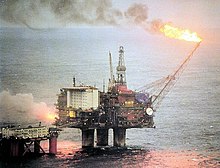Statfjord
Statfjord is an oil field in the North Sea . The field, discovered in 1974, is 85% in the Norwegian and 15% in the UK marine sector , but is operated by a joint operator under Norwegian law. The field was the largest oil field in the North Sea and at times the most important oil field. Originally, the field was supposed to go offline in the mid-1990s after 48% of the available oil had been recovered, but after several extensions the operator decided to keep Statfjord A in operation until at least 2027.
Oil and gas lie at depths of between 2500 and 3000 meters. They originated around 160 million years ago in the Jurassic and are located in sandstone formations , where oil and gas are found in the pores between the individual grains of sand.
exploitation
At peak times, the crew of the Statfjord A, B and C drilling rigs produced more than 700,000 barrels / day, the record was 850,204 barrels on January 16, 1987. Together with the satellite platforms Snorre A, Snorre B, Statfjord East, Statfjord North and Sygna, which were added later the field achieved an annual average of 819,091 barrels / day in 1995. By the 25th anniversary in 2004, Statfjord had produced four billion barrels of oil valued at 1045 billion Norwegian kroner and 70 billion cubic meters of natural gas.
The oil is loaded from the drilling rigs onto tankers and transported to the refineries. The gas from the Norwegian part of the field is transported with the Statpipe pipeline to the Norwegian mainland to Kårstø near Stavanger , while the gas from the British part goes to Scotland via the Brent field. Statfjord was the first oil field in which the then state-owned Norwegian oil company Statoil received a 50% share of the Norwegian reserves, a practice that Norway then continued with all subsequent oil fields discovered. The other 50% went to Mobil . Statoil / Equinor has been operating the field alone since 1987 (renamed 2018). In 2012 the oil production was 260,275 m³.
history
Norway announced the discovery of Statfjord on February 26, 1974. Test drilling began after Shell and Esso discovered the Brent oil field in the UK sector in 1972 , and the Norwegian government hoped it would spread to the Norwegian sector. They actually struck gold, but had discovered their own new oil field. Statfjord A started operations in 1977.
The three rigs are Condeep constructions. Each weighs about 250,000 tons, on which there are still 40,000 tons of process and residential facilities. When it was set up in May 1977, Statfjord A was considered the largest drilling platform in the world. The exploitation began with problems. Statfjord A was far more expensive than planned, and completion took a year longer than planned. In 1978 she was plagued by several accidents: 5 workers died in a fire in February, another 16 crashed in a helicopter that was supposed to bring the crew from Bergen to the oil rig.
In 1979 the island finally started regular production. Statfjord B followed in 1981 and started production in 1982 and Statfjord C in 1984/1985. Within a year, the cost of each of the drilling rigs was amortized. 620 workers are currently working in shifts on the drilling rigs. It was the first oil field on which female oil workers were also employed.
Others
There were two oil crises in the 1970s : one in 1973/74 and one in 1979/80. One led to a quadrupling of prices, the other to a further tripling. In total, the oil price increased twelve-fold . The gas price - traditionally linked to the oil price - followed; the price of coal and other energies also rose.
Web links
Coordinates: 61 ° 15 ′ 20 ″ N , 1 ° 51 ′ 14 ″ E
Individual evidence
- ↑ JP Casey: Asset life extension: viable in the long term for oil and gas? In: offshore-technology.com. May 6, 2020, accessed May 11, 2020 (UK English).

